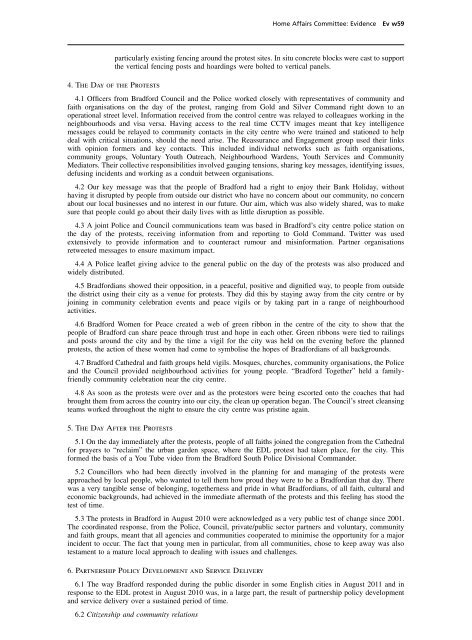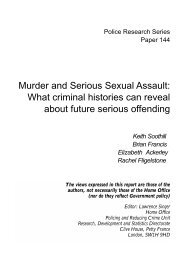Policing Large Scale Disorder: Lessons from the disturbances of ...
Policing Large Scale Disorder: Lessons from the disturbances of ...
Policing Large Scale Disorder: Lessons from the disturbances of ...
You also want an ePaper? Increase the reach of your titles
YUMPU automatically turns print PDFs into web optimized ePapers that Google loves.
Home Affairs Committee: Evidence Ev w59<br />
particularly existing fencing around <strong>the</strong> protest sites. In situ concrete blocks were cast to support<br />
<strong>the</strong> vertical fencing posts and hoardings were bolted to vertical panels.<br />
4. The Day <strong>of</strong> <strong>the</strong> Protests<br />
4.1 Officers <strong>from</strong> Bradford Council and <strong>the</strong> Police worked closely with representatives <strong>of</strong> community and<br />
faith organisations on <strong>the</strong> day <strong>of</strong> <strong>the</strong> protest, ranging <strong>from</strong> Gold and Silver Command right down to an<br />
operational street level. Information received <strong>from</strong> <strong>the</strong> control centre was relayed to colleagues working in <strong>the</strong><br />
neighbourhoods and visa versa. Having access to <strong>the</strong> real time CCTV images meant that key intelligence<br />
messages could be relayed to community contacts in <strong>the</strong> city centre who were trained and stationed to help<br />
deal with critical situations, should <strong>the</strong> need arise. The Reassurance and Engagement group used <strong>the</strong>ir links<br />
with opinion formers and key contacts. This included individual networks such as faith organisations,<br />
community groups, Voluntary Youth Outreach, Neighbourhood Wardens, Youth Services and Community<br />
Mediators. Their collective responsibilities involved gauging tensions, sharing key messages, identifying issues,<br />
defusing incidents and working as a conduit between organisations.<br />
4.2 Our key message was that <strong>the</strong> people <strong>of</strong> Bradford had a right to enjoy <strong>the</strong>ir Bank Holiday, without<br />
having it disrupted by people <strong>from</strong> outside our district who have no concern about our community, no concern<br />
about our local businesses and no interest in our future. Our aim, which was also widely shared, was to make<br />
sure that people could go about <strong>the</strong>ir daily lives with as little disruption as possible.<br />
4.3 A joint Police and Council communications team was based in Bradford’s city centre police station on<br />
<strong>the</strong> day <strong>of</strong> <strong>the</strong> protests, receiving information <strong>from</strong> and reporting to Gold Command. Twitter was used<br />
extensively to provide information and to counteract rumour and misinformation. Partner organisations<br />
retweeted messages to ensure maximum impact.<br />
4.4 A Police leaflet giving advice to <strong>the</strong> general public on <strong>the</strong> day <strong>of</strong> <strong>the</strong> protests was also produced and<br />
widely distributed.<br />
4.5 Bradfordians showed <strong>the</strong>ir opposition, in a peaceful, positive and dignified way, to people <strong>from</strong> outside<br />
<strong>the</strong> district using <strong>the</strong>ir city as a venue for protests. They did this by staying away <strong>from</strong> <strong>the</strong> city centre or by<br />
joining in community celebration events and peace vigils or by taking part in a range <strong>of</strong> neighbourhood<br />
activities.<br />
4.6 Bradford Women for Peace created a web <strong>of</strong> green ribbon in <strong>the</strong> centre <strong>of</strong> <strong>the</strong> city to show that <strong>the</strong><br />
people <strong>of</strong> Bradford can share peace through trust and hope in each o<strong>the</strong>r. Green ribbons were tied to railings<br />
and posts around <strong>the</strong> city and by <strong>the</strong> time a vigil for <strong>the</strong> city was held on <strong>the</strong> evening before <strong>the</strong> planned<br />
protests, <strong>the</strong> action <strong>of</strong> <strong>the</strong>se women had come to symbolise <strong>the</strong> hopes <strong>of</strong> Bradfordians <strong>of</strong> all backgrounds.<br />
4.7 Bradford Ca<strong>the</strong>dral and faith groups held vigils. Mosques, churches, community organisations, <strong>the</strong> Police<br />
and <strong>the</strong> Council provided neighbourhood activities for young people. “Bradford Toge<strong>the</strong>r” held a familyfriendly<br />
community celebration near <strong>the</strong> city centre.<br />
4.8 As soon as <strong>the</strong> protests were over and as <strong>the</strong> protestors were being escorted onto <strong>the</strong> coaches that had<br />
brought <strong>the</strong>m <strong>from</strong> across <strong>the</strong> country into our city, <strong>the</strong> clean up operation began. The Council’s street cleansing<br />
teams worked throughout <strong>the</strong> night to ensure <strong>the</strong> city centre was pristine again.<br />
5. The Day After <strong>the</strong> Protests<br />
5.1 On <strong>the</strong> day immediately after <strong>the</strong> protests, people <strong>of</strong> all faiths joined <strong>the</strong> congregation <strong>from</strong> <strong>the</strong> Ca<strong>the</strong>dral<br />
for prayers to “reclaim” <strong>the</strong> urban garden space, where <strong>the</strong> EDL protest had taken place, for <strong>the</strong> city. This<br />
formed <strong>the</strong> basis <strong>of</strong> a You Tube video <strong>from</strong> <strong>the</strong> Bradford South Police Divisional Commander.<br />
5.2 Councillors who had been directly involved in <strong>the</strong> planning for and managing <strong>of</strong> <strong>the</strong> protests were<br />
approached by local people, who wanted to tell <strong>the</strong>m how proud <strong>the</strong>y were to be a Bradfordian that day. There<br />
was a very tangible sense <strong>of</strong> belonging, toge<strong>the</strong>rness and pride in what Bradfordians, <strong>of</strong> all faith, cultural and<br />
economic backgrounds, had achieved in <strong>the</strong> immediate aftermath <strong>of</strong> <strong>the</strong> protests and this feeling has stood <strong>the</strong><br />
test <strong>of</strong> time.<br />
5.3 The protests in Bradford in August 2010 were acknowledged as a very public test <strong>of</strong> change since 2001.<br />
The coordinated response, <strong>from</strong> <strong>the</strong> Police, Council, private/public sector partners and voluntary, community<br />
and faith groups, meant that all agencies and communities cooperated to minimise <strong>the</strong> opportunity for a major<br />
incident to occur. The fact that young men in particular, <strong>from</strong> all communities, chose to keep away was also<br />
testament to a mature local approach to dealing with issues and challenges.<br />
6. Partnership Policy Development and Service Delivery<br />
6.1 The way Bradford responded during <strong>the</strong> public disorder in some English cities in August 2011 and in<br />
response to <strong>the</strong> EDL protest in August 2010 was, in a large part, <strong>the</strong> result <strong>of</strong> partnership policy development<br />
and service delivery over a sustained period <strong>of</strong> time.<br />
6.2 Citizenship and community relations
















